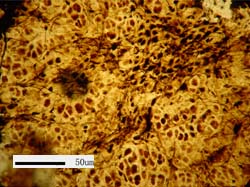
Lichens are believed to play a pioneering role in transforming the earth surface when they appeared on land hundreds of million years ago, paving the way for the evolution of terrestrial plants and animals. But most habitats where lichens dominate, such as tundra, mountains, and deserts, have a very low chance of preserving fossils. Until recently the earliest known lichen fossils were discovered in 1995 by Thomas N. Taylor, a University of Kansas researcher, from 400 million-year old deposits in Scotland.
A recent study conducted by researchers from China and the United States suggests that lichens may have existed on Earth 200 million years earlier than previously believed, and their work was reported in the May 13 issue of the magazine
Science.
The find was made by Prof. Yuan Xunlai from the CAS Nanjing Institute of Geology and Palaeontology, together with two US coworkers, in the Doushantuo Formation of Weng'an County in southwest China's Guizhou Province; the Doushantuo is well known for phosphatized marine algae and animals living in shallow seas about 600 million years ago. The Doushantuo fossils are exquisitely preserved at cellular level and in three dimensions.
The discovery adds to the scarce fossil records of fungi and throws new light on lichen evolution, according to Prof. Yuan, the lead author of the article.
Most people think of a lichen as a single organism. But it is actually a consortium of two organisms, or symbionts that work together to survive in a harsh environment. One of the symbionts, typically a cyanobacterium (also known as blue-green alga) or a green alga, produces food from carbon dioxide for the teamwork. The other organism is a fungus that provides nutrients, moisture and protection in the cooperation.
The Doushantuo lichens differ from their Scottish cousins not just in age, according to Thomas Taylor, one of the co-authors of the article. "They also occupied different environmental niches. The Scottish lichens were land dwellers", Taylor says, "while the Chinese fossils came from the sea."
The new discovery furnishes evidence that the fungi-algae collaboration was forged 600 million years ago or earlier, but new question arises, according experts. Was the collaboration carried over to land, or did each organism invaded land independently, then began to interact - independent of the previous relationship? The researchers believe that land-based lichenization probably evolved independently.
"The ability to form a symbiotic relationship between fungi and algae may have evolved long before the colonization of land by land-based lichens and green plants, which also form symbiotic relationships with various fungi," says Xiao Shuhai, another co-author of the article.
"The Doushantuo Formation opens a window into ancient marine life. There is a lot more remains to be learned from these rocks," Yuan notes.





